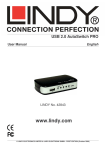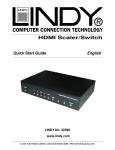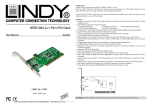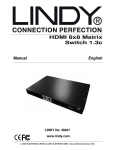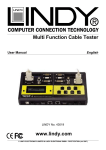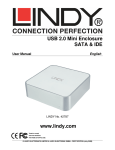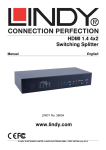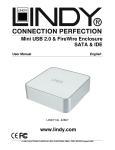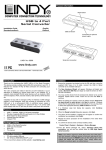Download Lindy 32762
Transcript
Cat5/6 VGA & Audio Extender Range Manual English LINDY No’s 32754, 32762, 32763, 32764, 32765 www.lindy.com © LINDY ELECTRONICS LIMITED & LINDY-ELEKTRONIK GMBH - FIRST EDITION (January 2011) Manual English Introduction Thank you for purchasing this product from the LINDY CAT5/6 VGA & Audio Extender range. This VGA Extender range consists of three transmitter units and two receivers which can be mixed and matched according to your requirements. Depending on the required video resolution, transmission distances of up to 250m are possible making the VGA & Audio Extender System an ideal choice for digital signage, public display and video distribution installations. The complete product range can be easily combined and expanded to suit a variety of applications through the use of low cost Cat5/6 cable. Taking advantage of Cat5/6 cable, installation is simplified and particularly cost effective whether you are splitting, extending or distributing VGA and audio signals. Installation Notes 1. Before connecting any devices, please ensure all equipment is powered off. 2. Proceed by connecting the transmitter module to your VGA source. Depending on the transmitter module purchased this may either be by direct connection or by using optional male to female VGA cables. 3. Please note that transmitter module No. 32754 is provided with a special combined VGA + Audio and USB cable for connection to your computers VGA card. If you have purchased No. 32762 then you will need to purchase a suitable male to female VGA cable. 4. If you intend to connect a sound source and speakers then use a standard 3.5mm jack male to male cable between your sound card and the transmitter module. Please note that No. 32754 and 32764 have a short audio cable with a 3.5mm jack plug already attached for connection to your sound card and speakers. 5. Connect the transmitter and receiver modules using a suitable Cat5/6 network patch cable of the required length. This may be a loose cable or you can make use of your cable infrastructure via wall plates and patch panels. Please note the extender system requires a point to point connection and must not be connected to any active network equipment. 6. Connect a local VGA monitor and speakers to the transmitter module if required (No. 32762, No. 32764). Locate the receiver unit and connect the remote VGA monitor and, speakers if required. 7. Check all connections have been made correctly and apply power to the transmitter and receiver modules. Once completed check for correct displays on both the local and remote monitors. Manual English Typical applications Choose any of the following configurations depending on the number of displays and the operating distance required. Additional receiver modules can be purchased as your system expands. Receiver unit No. 32765 and transmitter unit No. 32763 are fitted with a convenient magnetic base allowing easy installation to any metal surface. Transmitter 32754 Transmitter 32763 Transmitter 32762 Cat5/6 or higher cable, up to 150m Cat5/6 or higher cable, up to 250m Cat5/6 or higher cable, lengths are determined by the Receiver. Up to 8 Receivers can be connected. Manual English 1-Port VGA & Audio Transmitter 150m No. 32754 1. 2. 3. 4. 4 Audio input from sound card USB power cable VGA input from video card RJ-45 output to receiver via Cat5/6 cable 1 3 2 4 1-Port VGA & Audio Receiver 150m No. 32764 1. 2. 3. 4. Audio output to remote speakers Power adapter input with focus control VGA output to remote monitor RJ-45 input from transmitter via Cat5/6 cable 2 3 1 Key Features: Compact transmitter and receiver modules allow VGA and Audio signals to be extended over long distances using low cost Cat5/6 cables. The transmitter unit attaches to your VGA output and sound card, and is powered by the computer’s USB port. The receiver unit attaches to your remote VGA monitor and speakers and features a focus control for adjusting the picture quality. • • • • • • Compact AV Transmitter and Receiver modules Transmitter module powered from USB port Extends VGA + Audio over Cat5/6 cable up to 150m Built in focus control for adjusting picture quality (receiver) H. Sync and V. Sync activity indicators Supports DDC2B Manual English 1-Port VGA & Audio Transmitter 250m No. 32763 1. 2. 3. 4. 5. 6. 7. Power status indicator Power adapter input (5 Volts DC, 1.2Amp) VGA output to local monitor Audio output to local speakers VGA + Audio and power input via combined VGA + Audio and USB power cable RJ-45 output to receiver via Cat5/6 cable H. Sync and V. Sync activity indicators (RJ-45 port) 1 7 2 3 4 5 6 1-Port VGA & Audio Receiver 250m No. 32765 1. 2. 3. 4. 5. 6. 7. Power status indicator Power adapter input (5 Volts DC, 1.2Amp) VGA output to remote monitor Audio output to remote speakers Gain and focus controls for adjusting picture quality RJ-45 input from transmitter via Cat5/6 cable H. Sync and V. Sync activity indicators (RJ-45 port) 1 7 Key Features: 2 3 4 5 6 Compact single port transmitter and receiver modules allow VGA and Audio signals to be extended over long distances using low cost Cat5/6 cables. The transmitter unit attaches to your VGA output and sound card and is powered by the computers USB port. • • • • • Compact single port AV extender Extends VGA + Audio signals over Cat5/6 cable up to 250m Focus and gain controls for adjusting picture quality Supports DDC2B Magnetic base Manual English 8-Port VGA & Audio Transmitter 250m No. 32762 1. 2. 3. 4. 5. 6. 7. 8. VGA activity indicator Power status indicator Power adapter input (5 Volts DC, 1.2Amp) VGA input from video card Audio input from sound card VGA output to local monitor Audio output to local speakers VGA + Audio outputs to receivers via Cat5/6 cable 1 3 4 5 2 6 7 8 Key Features: Compact eight port transmitter module allows multiple VGA and Audio signals to be extended over long distances using low cost Cat5/6 cables. • • • • Compact eight port AV splitter/transmitter module Extends multiple VGA + Audio signals over Cat5/6 cable up to 250m Supports DDC2B May be cascaded to allow extender modules to be located at intervals of 250m Manual English CE Certification This equipment complies with the requirements relating to electromagnetic compatibility, EN55022/EN55024 class B for IEC/EN61000-4-2/3 the essential protection requirement of Council Directive 89/336/EEC on the approximation of the laws of the Member States relating to electromagnetic compatibility. FCC Certification This equipment has been tested and found to comply with the limits for a Class B digital device, pursuant to part 15 of the FCC Rules. These limits are designed to provide reasonable protection against harmful interference in a residential installation. This equipment generates, uses, and can radiate radio frequency energy and, if not installed and used in accordance with the instructions, may cause harmful interference to radio communications. However, there is no guarantee that interference will not occur in a particular installation. If this equipment does cause harmful interference to radio or television reception, which can be determined by turning the equipment off and on, the user is encouraged to try to correct the interference by one or more of the following measures: • Reorient or relocate the receiving antenna • Increase the separation between the equipment and receiver • Connect the equipment into an outlet on a circuit different from that to which the receiver is connected • Consult the dealer or an experienced technician for help You are cautioned that changes or modification not expressly approved by the party responsible for compliance could void your authority to operate the equipment. This device complies with part 15 of the FCC Rules. Operation is subject to the following two conditions: 1. This device may not cause harmful interference, and 2. This device must accept any interference received, including interference that may cause undesired operation. WEEE (Waste of Electrical and Electronic Equipment), Recycling of Electronic Products United Kingdom In 2006 the European Union introduced regulations (WEEE) for the collection and recycling of all waste electrical and electronic equipment. It is no longer allowable to simply throw away electrical and electronic equipment. Instead, these products must enter the recycling process. Each individual EU member state has implemented the WEEE regulations into national law in slightly different ways. Please follow your national law when you want to dispose of any electrical or electronic products. More details can be obtained from your national WEEE recycling agency. Germany Die Europäische Union hat mit der WEEE Direktive umfassende Regelungen für die Verschrottung und das Recycling von Elektro- und Elektronikprodukten geschaffen. Diese wurden von der Bundesregierung im Elektro- und Elektronikgerätegesetz – ElektroG in deutsches Recht umgesetzt. Dieses Gesetz verbietet vom 24.März 2006 an das Entsorgen von entsprechenden, auch alten, Elektro- und Elektronikgeräten über die Hausmülltonne! Diese Geräte müssen den lokalen Sammelsystemen bzw. örtlichen Sammelstellen zugeführt werden! Dort werden sie kostenlos entgegen genommen. Die Kosten für den weiteren Recyclingprozess übernimmt die Gesamtheit der Gerätehersteller. France En 2006, l'union Européenne a introduit la nouvelle réglementation (DEEE) pour le recyclage de tout équipement électrique et électronique. Chaque Etat membre de l’ Union Européenne a mis en application la nouvelle réglementation DEEE de manières légèrement différentes. Veuillez suivre le décret d’application correspondant à l’élimination des déchets électriques ou électroniques de votre pays. Italy Nel 2006 l’unione europea ha introdotto regolamentazioni (WEEE) per la raccolta e il riciclo di apparecchi elettrici ed elettronici. Non è più consentito semplicemente gettare queste apparecchiature, devono essere riciclate. Ogni stato membro dell’ EU ha tramutato le direttive WEEE in leggi statali in varie misure. Fare riferimento alle leggi del proprio Stato quando si dispone di un apparecchio elettrico o elettronico. Per ulteriori dettagli fare riferimento alla direttiva WEEE sul riciclaggio del proprio Stato. LINDY No’s. 32754, 32762, 32763, 32764, 32765 1st Edition January 2011 www.lindy.com








